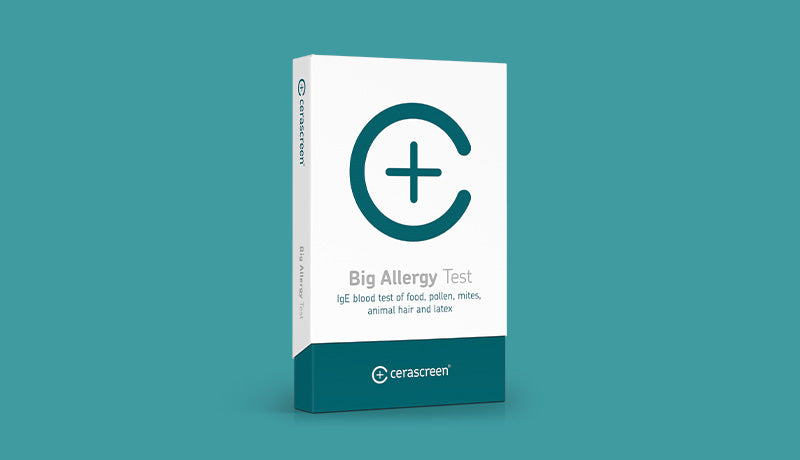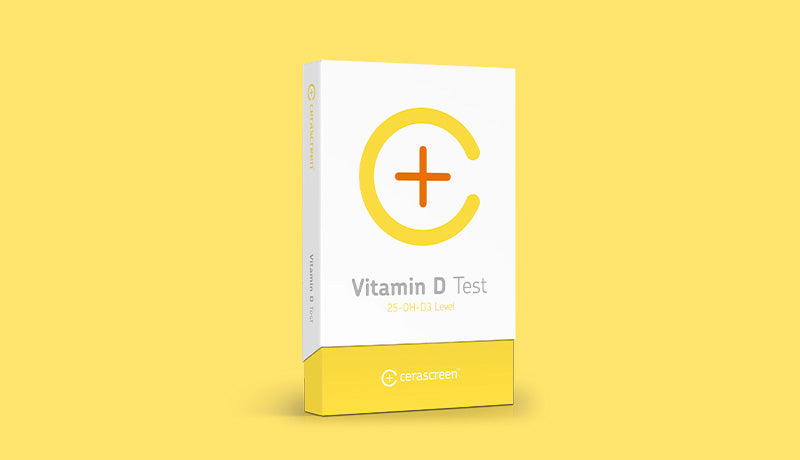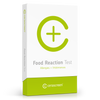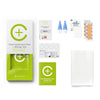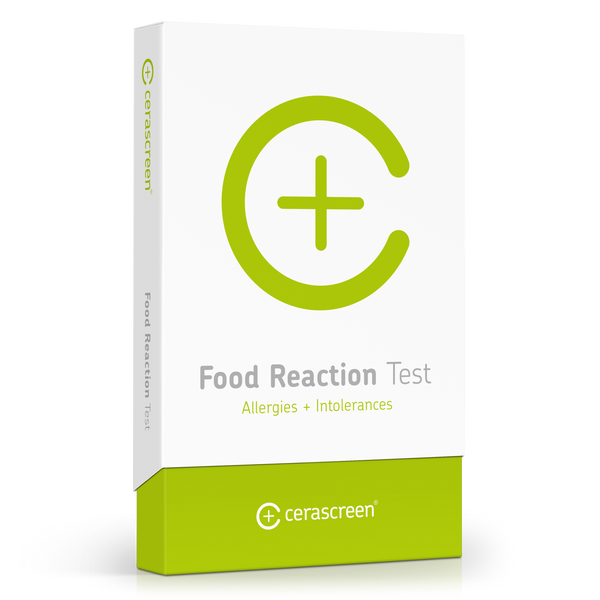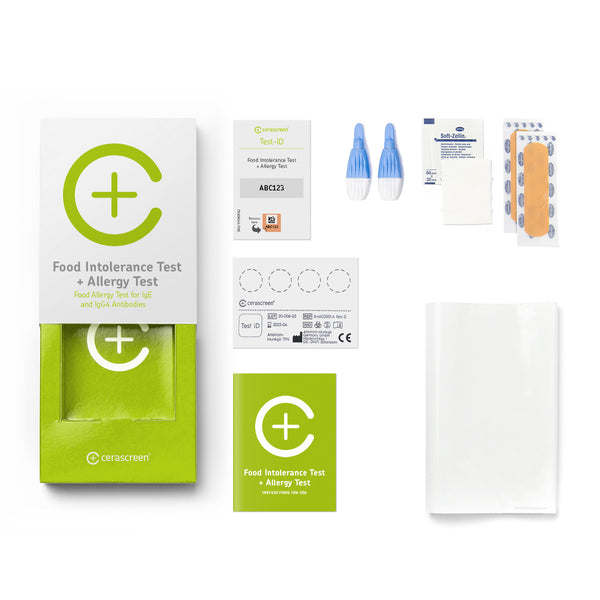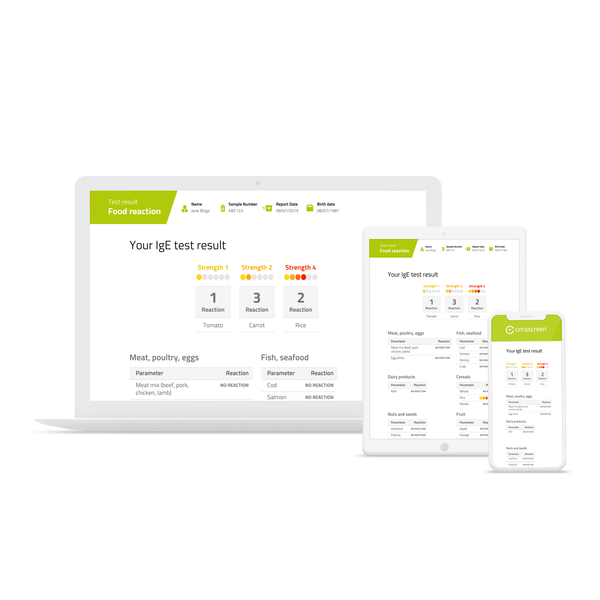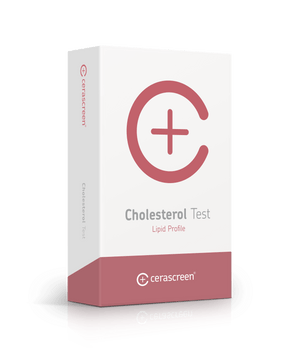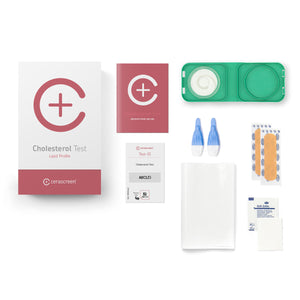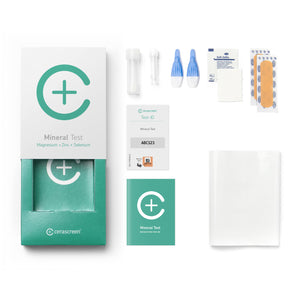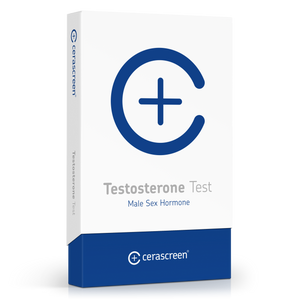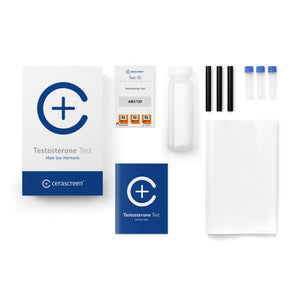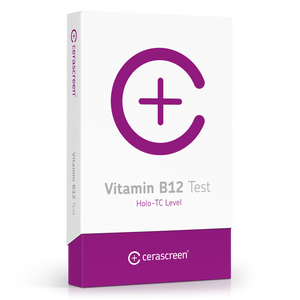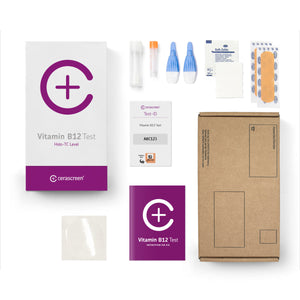product_id = 9826001671variant_id = 38258657799template_name =
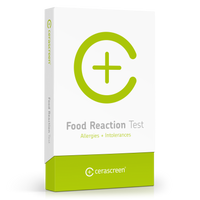
Food Intolerance Test & Food Allergy Test
About the test
With the food intolerance test kit, you can test for food intolerances and food allergies. The cerascreen® Food Reaction Test is a sample collection and mail-in kit to measure the concentration of specific IgE antibodies to 24 different foods and the concentration of specific IgG4 antibodies to 38 different foods. Do you have unanswered discomfort or pain and do not know where to start? This food reaction test offers you a helpful initial orientation.
With the sample collecting and mail-in home kit, you can quickly and easily find out whether your body reacts with antibodies towards the usual food allergy and intolerance culprits – simply by collecting a small blood sample.
Our laboratory measures the concentration of IgE and IgG4* antibodies in your blood. The food intolerance test thus provides you with initial indications that you can easily follow up on. For a final diagnosis, you can discuss possible allergies with your general practitioner.
Table: List of foods against which IgE antibodies are measured
| Food group |
IgE antibodies tested |
IgG4 antibodies tested |
|---|---|---|
| Meat and eggs |
Beef, pork, chicken, lamb, egg whites |
Pork, beef, lamb, chicken, turkey, egg white, egg yolk |
| Fish and seafood | Cod, salmon, shrimp, crab |
Cod, shrimp |
| Dairy |
Cow's milk |
Cow’s milk, casein |
| Cereals and starchy foods |
Wheat, rice, potato |
Spelt, wheat, rye, oats, rice, potato |
| Nuts,legumes and seeds |
Hazelnut, peanut, almond, mustard, soya |
Hazelnut, peanut, almond, soya, walnut, mustard |
| Fruit |
Apple, orange, strawberry, kiwi, peach |
Apple, orange, strawberry, kiwi, peach, banana |
| Vegetables |
Tomato, carrot, celery |
Tomato, carrot, celery, onion |
| Other |
- |
Gluten, coffee, sesame, pepper (black), baker’s yeast |
Food Intolerance Test & Food Allergy Test
- Obtain a blood sample easily from the convenience of your home
- Find out the presence of specific IgE and IgG4 antibodies in your blood
- Receive recommendations and tips that are easy to implement
- Receive your results within a few days after the sample’s arrival at the lab
What is tested?

Vegetable:
Tomato, carrot, onion, celery, potato

Fruit:
Apple, banana, kiwi, strawberry, peach, orange

Egg and dairy products:
Egg white, cow's milk, casein

Meat:
Beef, pork, lamb, chicken, turkey

Fish:
Cod, salmon, tuna, prawns

Nuts, seeds and legumes:
Walnut, hazelnut, almond, peanut, sesame, soy

Cereal:
Wheat, spelt, rye, oats, gluten, baker's yeast, rice

Other:
Mustard, coffee, black pepper
Hint: The fact that an increased concentration of specific IgG4 antibodies is associated with food intolerance is medically controversial.
Benefits of the Food Intolerance Test & Food Allergy Test
There are countless different food allergies and food intolerances and almost as many tests to get to the bottom of them. Do you have unanswered discomfort or pain and do not know where to start? Then the cerascreen® Food Reaction Test will offer you a helpful initial orientation. Food intolerances or allergies can not only be responsible for gastrointestinal complaints. They often manifest themselves through symptoms such as tiredness, skin irritation and a burning sensation in the oral cavity. Without a food intolerance test, it is often difficult to identify the causes of such symptoms in everyday life. Want to gain more insights into the differences between a food allergy and intolerance? Visit our Health Portal for all you need to know about this trending topic.
To take the cerascreen® Food Intolerance Test & Food Allergy Test there is no need for you to visit your general practitioner, drive to a clinic or wait for an appointment. To collect the sample, you will receive detailed, illustrated instructions, and after the analysis, you will be provided with a detailed overview of the concentration of antibodies to certain foods. To identify only certain food allergies, click on the link to learn more about the cerascreen® Food Allergy Test.
Benefit from our expertise: cerascreen® is the market leader in Europe for medical sampling and send-in kits, with eight years of experience in the development and evaluation of tests. We have developed more than 50 approved send-in test kits (medical products), evaluated 250,000 samples and serve 19 countries.

Result of the Food Intolerance Test & Food Allergy Test
As soon as your sample has been analysed, you will receive your results report via the My cerascreen® app or your user account on our website. You can easily view the report on your smartphone, tablet or computer and read it in printed form, if required.
The laboratory analysis determines the concentration of specific IgE antibodies against certain grass types, herbs and flower pollen in your blood. Learn what you can do to relieve your symptoms during the pollen season with the help of our recommendations. Extensive health information explains the background of pollen allergies, cross-allergies and much more.
Frequently asked questions about Food Intolerance Test & Food Allergy Test
Why test for food intolerance and allergies?
Many people suffer from food allergies and intolerances – often without knowing it. In some cases, it is difficult to identify symptoms after consuming a certain food in day-to-day life. In the case of food intolerances, reactions can also be quite delayed. A Food Intolerance Test provides valuable and helpful information on which foods might not be tolerated.
Our Food Intolerance Test & Food Allergy Test offers an initial orientation: both specific IgE antibodies and IgG4 antibodies are determined for a wide range of foods. A large proportion of all food allergies and intolerances can be traced back to the foods examined in the test.
Please note: The cerascreen® Food Intolerance Test & Food Allergy Test does draw any conclusions about intolerances to lactose, fructose, sorbitol, histamine or gluten. This is due to the fact that these intolerances are not based on IgE and IgG4 antibodies. Cerascreen® offers additional intolerance tests for lactose, fructose, sorbitol, histamine and gluten.
How do you test for intolerances?
To take the food intolerance test, collect a small blood sample from your fingertip with one of the enclosed lancets. Only a few drops of blood are needed.
Return the sample using the free return envelope enclosed in the test kit. In the medical laboratory, the sample will be analysed to determine the level of certain IgE and IgG4 antibodies in the blood sample. When the analysis is complete, you will receive a notification and be able to access the results report easily when you log in to our website or even via the My cerascreen® app.
Important: You will get the most reliable results if you have followed a balanced diet for about two weeks before taking the sample. Also, please do not eat any foods that you know might cause a reaction (for example, anaphylactic shock). Please do not take any antihistamines either.
What do the results tell me?
The results report of the Food Intolerance Test & Food Allergy Test shows for which foods there are larger amounts of IgE and IgG4 antibodies in your blood sample.
A table shows to which extent you are sensitised to 24 different foods and food groups, meaning whether there are too many of the food-specific IgE antibodies in your blood sample. This sensitisation tells you the likelihood of your immune system having allergic reactions to a certain food.
The other table shows you how many IgG4 antibodies to 38 foods are present in the blood. According to alternative medical theories, a medium or reaction can give a first indication of whether or not there might be any food intolerances.
How long does the analysis take in the laboratory?
Once your sample has arrived at the laboratory, it will be analyzed there by specialists. How long the analysis takes depends on the exact measuring method and the processes in the laboratory.
If the sample is sent on the correct days (Sunday to Tuesday), this makes it easier for the laboratory to adhere to the times.
For the Food Intolerance Test & Food Allergy Test, the laboratory analysis is usually completed within 5 working days after the sample is received in the laboratory.
What kind of recommendations will I receive?
Neither the IgE nor IgG4 levels are in themselves a diagnosis. Only general practitioners can diagnose an allergy or intolerance with certainty. In both cases, it is possible that elevated levels are not associated with any discomfort you may be experiencing.
You can use the Food Intolerance Test & Food Allergy Test results as a first indication to discuss further steps with your GP. The results report also provides you with tips on how you can further explore which foods you can and cannot tolerate by eliminating certain foods from your meal plan.
You will also receive recommendations on how to deal with identified allergies and intolerances and how to keep your diet balanced.
Does the NHS do food intolerance testing?
The NHS does not offer an intolerance test. The NHS recommend that you visit your doctor if symptoms are particularly uncomfortable or acute and if you are unsure about what is triggering your symptoms. The majority of food intolerance testing is done privately via blood tests, the most reliable test being food-specific IgG reaction tests.
What do ‘IgE’ and ‘IgG4’ mean?
Immunoglobulins E (IgE) and Immunoglobulins G4 (IgG4) are two types of antibodies. They are part of the defence component of the immune system. Both IgE and IgG4 are groups of specific antibodies that are specialised in defending against very specific foreign bodies.
In the case of an allergy, specific IgE antibodies are found in a too high frequency in the body. They cause the immune system to dysfunction when harmless proteins from pollen, animal hair or even food enter the body. The messenger substance histamine is then released, leading to inflammation and the typical allergy symptoms.
IgG4 food intolerance is an alternative medical theory that is currently not supported by scientific studies. According to the theory, an increased number of specific IgG4 antibodies leads to defensive and inflammatory reactions. The symptoms should usually appear with a time delay – up to hours or days after you have eaten the intolerable food.
What kinds of food intolerances will be tested?
In the case of a food allergy or food intolerance, the symptoms usually appear immediately or shortly after eating. Nuts, soya and animal foods such as milk, eggs and shellfish, in particular, can also trigger a harmful allergic reaction (anaphylactic shock), during which a sudden drop in blood pressure can lead to fainting and, in rare cases, death.
Typical symptoms of food allergy or food intolerance: - skin rashes - gastrointestinal discomfort such as diarrhoea and abdominal pain - An itchy palate and ‘furry tongue’ - Respiratory problems to allergic asthma
Which kind of foods causes allergies?
More than 170 foods can be the cause of allergies and food intolerances. However, there are some foods that are by far the most common triggers. These include: - cow’s milk and eggs - pulses - nuts - wheat - fish and shellfish
Allergies to various types of fruit, vegetables and spices are somewhat less common.
Most food allergies emerge during childhood. Allergies to cow’s milk, eggs, wheat and soya often develop during adolescence, while allergies to nuts, fish and shellfish usually last for a lifetime.
Can food intolerances go away?
There is currently no cure for food intolerances – the best recommendation is to avoid the food that is causing you discomfort, or reduce the amount of it that you consume.
Alternatively, a good way to see if an intolerance goes away is to exclude the problematic food from your diet. This is called an elimination diet. If you have a food intolerance to more than one food, exclude one food item at a time. See if you notice your symptoms subside after two to six weeks; if they do, start reintroducing the food to see if symptoms come back.
Please note: When you eliminate certain foods from your diet, you should still maintain a balanced and healthy diet.
What are IgG4 intolerances?
According to an alternative medical theory, high concentrations of specific IgG4 antibodies are a sign of an intolerance to certain foods. According to this theory, inflammatory reactions occur in the gut after the consumption of food.
This link between the concentration of IgG4 antibodies and the presence of food intolerances is currently the subject of scientific controversy.
Why are children under 18 not allowed to take the test?
Our tests are not suitable for underage children and adolescents under the age of 18. Under 18s cannot activate the tests online and therefore cannot receive a test result. We ask that you do not administer the tests to your children either.
Children and adolescents need much closer supervision and counselling regarding medical tests and their interpretation. Testing with lancets and chemicals is not without risk and would need to be closely supervised by guardians. In addition, the reference values we give are always based on adult data. In the case of children, the risk of misinterpreting the results would be very high.
We want to fulfil our responsibility as a provider of medical products and ensure that children and adolescents are not unsettled by measurement results that are difficult for them to interpret. Since we cannot control whether the minors' legal guardians actually consent to the test being carried out and supervise them, we exclude tests for under 18s altogether.
If you are under 18 and have purchased a test, please contact our customer support.
Can I use the test to detect lactose intolerance or fructose intolerance?
The Food Intolerance Test & Food Allergy Test does not test for Lactose Intolerance Test and Fructose Intolerance Test. Histamine intolerance cannot be detected with this type of antibody blood test either. With the food reaction test, you get indications of reactions of the immune system to specific proteins (allergens), which in the case of IgE antibodies indicates, for example, allergies.
For other, special antibodies must be examined, for which other laboratory procedures are necessary. An analysis of the enzyme DAO in the blood provides an indication of histamine intolerance.
Lactose intolerance and fructose intolerance are not examined by blood test. A breath gas test is common here, in which it is analysed whether more gases such as hydrogen and methane are formed after ingestion of lactose or fructose and enter the air we breathe.
Here you will find other cerascreen tests that you can use to get tested for certain intolerances:
Why does the test have an expiration date?
The cerascreen® test kits are CE-marked medical devices, which in turn include other certified medical components such as lancets, patches, and alcohol swabs used in blood tests.
Like most medical devices, these components have an expiration date to ensure that they remain safe and effective. Many of our sample carriers – such as dried blood cards or sample tubes – are chemically treated to keep your sample stable and analyzable in our laboratory. Over time, environmental factors can affect this treatment and compromise accuracy.
Our sterile, single-use lancets also carry an expiration date to guarantee sterility and safe use up to that time.
This is how it works
1. Test at home
Your test kit contains everything you need to draw a small sample of blood from your fingertip. Then send the sample back to us free of charge in the enclosed return envelope.
2. View results online
After the evaluation in the medical specialist laboratory, you will have online access to your personal result report.
3. Act
Your access to the test results and the evidence-based findings and tips to improve your health: the my cerascreen® user profile on our website or our app.
